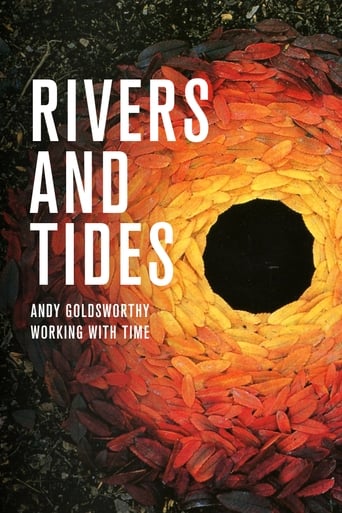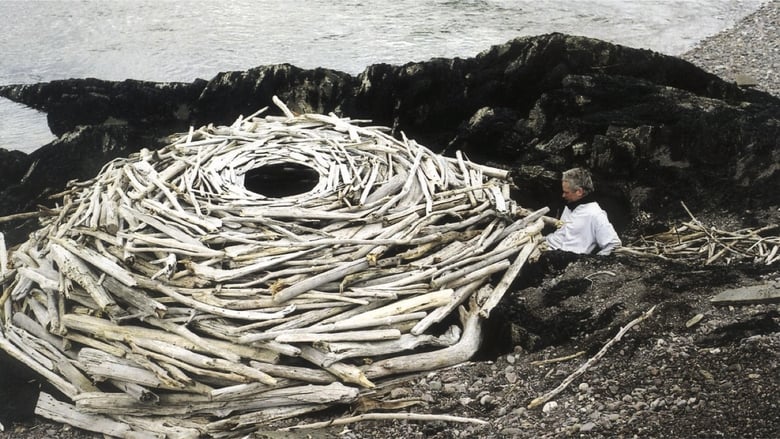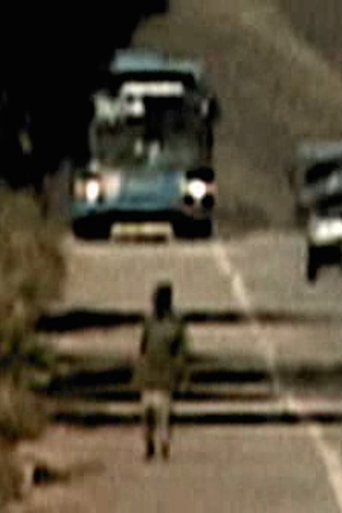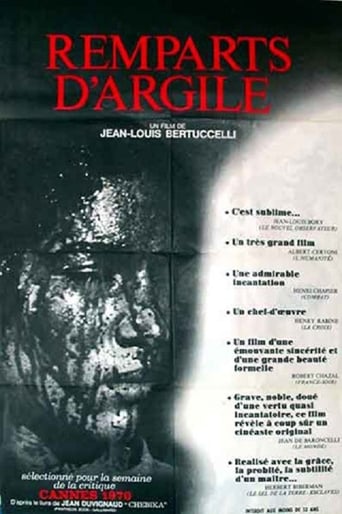

Rivers and Tides (2001)
Portrait of Andy Goldsworthy, an artist whose specialty is ephemeral sculptures made from elements of nature.
Watch Trailer
Cast


Similar titles
Reviews
An absolutely wonderful documentary which explores the creative process of Scottish artist Andy Goldsworthy, whose specialty is making art in the natural environment using natures materials: leaves, rock, twigs etc. By there very nature these works of art he so painstakingly creates are temporary, lasting, in some cases, just a matter of hours. This wonderful film provides us with many memorable images: a delicate ice structure melting in the early morning sun; a beehive hut constructed on a river bank with the branches of trees, being gently and carefully carried away by the tide. Goldsworthy says he does not see nature as destroying his structures but,rather, extending the process of creation, bringing his work onto another plane.The only voice we hear is Galsworthy's as he explains his work and his view of the world. It's not all plain sailing; we see his frustration as something he's worked on for hours collapses or is blown away by a gust of wind. On an aesthetic level, the movie is faultless as it gently reveals the artists wondrous view of nature and its beauty. A movie that draws you in as it explores the mysteries of the creative process. A joy to watch. Highly recommended.
A very engaging documentary about Scottish artist Andy Goldsworthy, whose work consists mostly of ephemeral sculptures made from elements from nature. His work is made of rocks, leaves, grass, ice, etc., that gets blown away when the tide arrives at the beach or the wind blows at the field. Thus, most of Goldsworthy's works don't really last, except as photos or films of what they were. Now, one can argue that Goldsworthy's works are a reflection of mortality, or words to that effect, but isn't it easier to say that what he does is just beautiful art. And at a time when the stereotype about artists is that they are mostly bitter, pretentious, often mentally unstable people who live in decrepit urban settings, Goldsworthy seems to be the opposite: a stable, unpretentious, family oriented person who loves nature and lives in a small village in Scotland (of course, I'm sure those are the same reasons why he's shunned by some people on the art world who found his works fluffy or superficial).
Greetings again from the darkness. Insight into the mind and motivation of a wonderful artist. How strange for most of us to see someone who MUST work... no matter the conditions, else his reason for living ceases. To see Goldsworthy's sculptures come alive and to see his reaction to each is extremely voyeuristic. This artist creates because he must - not for money or fame. It is his lifeforce. When you see his failures, energy seems to expel from his body like a burst hot air balloon. It is not the dread of beginning again, it is that he takes his energy from his work. Watching him create just to have nature takeover and recall his work is somewhat painful, but nonetheless, breathtaking. He discusses flow and time in the minimal dialog and there appears to be little doubt that the artist and the earth are one in the same. When he says he needs the earth, but it does not need him ... I beg to differ. Only complaint is the musical score seems to slow down further a pace that is relaxing at best.
I finally saw `Rivers and Tide.' I want to say that as an artist I'm happy that at least in the San Francisco area this documentary is having a long and successful run. It's nice that a film about an artist, one that gets close to him and his work, is reaching people so successfully. It's a nice film, and it creates a sort of warm and pleasant feeling for the engaging and dedicated Andy Goldsworthy, the 47-year-old Scottish artist who makes perishable environmental pieces whom this doc is exclusively concerned with. My friend Spencer thought `Rivers and Tides' was unbelievably boring. He's not so far off: this is a very quiet and repetitious film. There are, moreover, times when the viewing experience is like watching paint dry. But this is not a condemnation on my part. Samuel Beckett's plays and novels are almost unbearably boring and yet I consider him a genius and perhaps the greatest playwright in English of the twentieth century. But let us bear in mind that `Rivers and Tides' is not very exciting and that since Goldsworthy is largely repeating the same sorts of pieces over and over again, it's very repetitious. His strings of leaves, or hair, or wool, or his wreathes of sticks, or ice, or his piles of rocks in cone shapes, or circles, or spirals, or lines, are done over and over, and the film focuses constantly on Goldsworthy working on piece after similar piece. It is clearly the desire of Thomas Riedelsheimer, the filmmaker, to stay out in the wilds of nature in Nova Scotia or New York State or Scotland where the artist spends his time, and not to take us to the world of dealers and galleries which he largely avoids (though they still promote and support him), nor to bring in a host of critics or admirers to talk about him.It's ironic though since Andy Goldsworthy himself says there are so many things he can't express -- he breaks down in his explanations more than once -- and that the work says it so much better than he can, the documentarian nonetheless chooses to have him almost constantly talking throughout the film. Since the pieces are about nature and its forces, why not let nature speak with its own voice instead of having the artist natter on? He spouts a lot of commonplaces about how you have to take time to watch things change, how deep the forces of nature are, and on and on. His pieces are often stunningly beautiful, as shown in books; why doesn't the film show more of those beauties close up, framed for a moment in time, as Goldsworthy's own stills do?Instead it focuses first off on several of his failures, on piles of stones that collapsed into a heap over and over. These moments are telling, though, because they show the patience and endurance of the man. His face is soft and sweet. He is really a very dear fellow, dedicated to his work and drawing satisfaction and knowledge directly from it. He has a lovely family, a wife and three or four small kids living in a rural Scottish town. I don't know much about them because the filmmaker treats them as mere furniture, relentless in his focus on the artist and his works. We only see enough of them to know he has a family at all and also to see that this isn't just saintly doodling of a hermit out in the woods but that the man has a `home base,' a nice house, a staff, a huge file, and all the systematic organization of work and its records that goes with being a highly successful and indeed internationally known artist. Basically Goldsworthy, whose work is nonetheless worthy, is a recycler of the earthworks and environmental art of the Sixties and Seventies. He is not a pioneer like Michael Heizer, or like Robert Smithson, whose `Spiral Jetty' his pieces sometimes echo. He has none of the human interaction and social consciousness of Christo and Jeanne-Claude. He goes off by himself. He's gentle with nature; his pieces are generally meant to collapse and fade back into the environment from whence they came. When the film shows a highway in New York State with semi's rolling on it, you're jolted back to reality. Goldsworthy is generally so cut off from the public and from our times in his work, so touchy-feely and spiritual in his ponderings, that he could be living in the Fifties, and this could be one of the excellent artist documentaries that were made at that time, were it not for the fact that he needed the forerunners of environmental art to come before him. `Rivers and Tides' is a gentle piece, a nice date movie for couples in their fifties or sixties. It's uncontroversial, peaceful, and soothing. It's a travelogue without boring natives or national problems. It's a nature exploration film without environmental issues or deaths or illnesses or injuries-the worst thing that happens to the artist is that he gets chilly and scrapes his fingers or that his piece falls over unfinished after hours of work and he almost wants to cry. He makes his delicate networks of icicles with his bare hands, because he has to be able to feel the ice to do the piece. He may be a famous guy now, with commissions that provide enough to have a team of ten or more resurfacing an interior in Digne, France with Scottish mud mixed with Scottish human hair or building curly stone walls in New York State, but he stays honest by going out and making his pieces himself and, from the sound of it (the film doesn't tell us anything that Andy Goldsworthy doesn't mention himself) he still photographs them himself, and most people who haven't seen a gallery installation know his work from the big books of photographs that have kept coming out over the last decade or so. The film documents the making of the pieces, trying to cover a lot of them and therefore not gong into great depth about any. But would we want to see full coverage of six hours of trying to make pile of stones stay together, and falling down four times in a row?Not that there are not beauties in the film. The end, when Goldsworthy is throwing things in the air and letting them fall into the water, are stunning gentle natural explosions. (The music by is unobtrusive and sometimes beautiful.) But the fact is that the images in `Rivers and Tides' cannot compete with the stills in Andy's books as expressions of the aesthetic beauty of his work. Nor are, ultimately, his words necessary for those who truly look.






